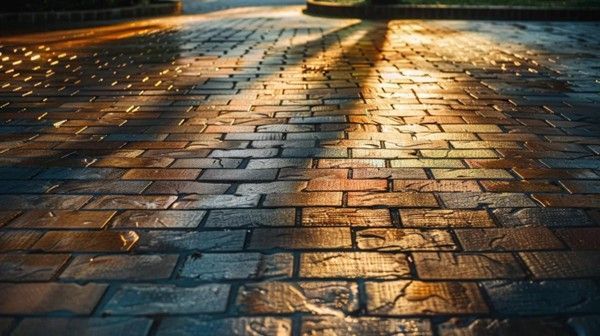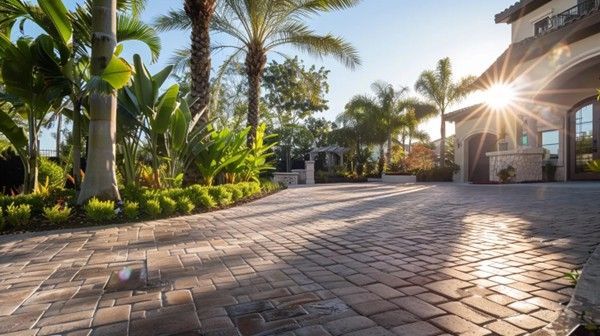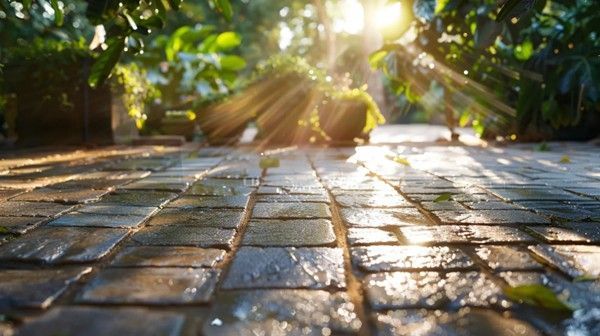Paver Sealing vs. No Sealing: What You Should Choose
Paver sealing is often seen as an optional extra, but it can greatly impact the durability and appearance of your landscape. Homeowners may wonder about the differences between sealed and unsealed pavers, especially in regions with extreme weather conditions.
This article will cover key differences between sealing and not sealing pavers, factors influencing your decision, and steps for proper sealing. By understanding these aspects, readers will learn how paver sealing services can enhance their home’s aesthetics and extend the lifespan of their outdoor surfaces, addressing concerns about porosity and overall maintenance.
Key Takeaways
- Sealing pavers protects them from damage caused by weather and stains
- Unsealed pavers require more maintenance and can lead to costly repairs over time
- Proper sealing enhances the appearance and longevity of outdoor spaces
- The type of sealant and application technique significantly impact sealing effectiveness
- Consulting professionals helps homeowners make informed choices about paver sealing
Understanding Paver Sealing and Its Impact

Paver sealing involves applying a protective layer to surfaces such as driveways using paver sealingservices, which shields them from damage caused by pressure washing, snow, and natural elements like moss.
The benefits include enhanced durability, easier maintenance, and improved aesthetic appeal. Conversely, not sealing pavers increases the risk of deterioration and costly repairs. Understanding these factors helps homeowners make informed choices.
Defining Paver Sealing
Paver sealing is the process of applying a protective coating to surfaces such as patios and driveways. This treatment guards against issues such as dirt accumulation, humidity-related water damage, and the growth of moss.
Homeowners who seal their pavers can expect easier maintenance and a longer lifespan for their outdoor spaces, ultimately saving on costly repairs.
For those considering this investment, it can be beneficial to request a quote from a professional sealing company to understand the specific services available and associated costs.
Identifying Benefits of Paver Sealing
Paver sealing offers significant advantages that homeowners should consider when deciding whether to seal their surfaces.
This process protects pavers from erosion caused by heavy rains and harsh climate conditions, ensuring their longevity and structural integrity.
By sealing the surfaces, debris and moisture are less likely to accumulate, making routine maintenance easier and keeping decks and patios looking pristine year-round.
Key Differences Between Sealed and Unsealed Pavers

The differences between sealed and unsealed pavers primarily affect aesthetic variations in appearance, maintenance requirements, and long-term costs.
Sealing enhances the look of walkways and brick surfaces while minimizing mold buildup and insect infestations. Understanding these aspects allows homeowners to make smart decisions regarding the longevity and upkeep of their outdoor spaces.
Comparing Maintenance Requirements
Maintaining both sealed and unsealed pavers involves different levels of effort and attention. Sealed surfaces are generally easier to care for, as the protective layer helps to repel moisture and prevents oil stains from penetrating the pavers. This can be particularly advantageous for hardscape features like retaining walls and curbs, which may be exposed to spills and debris.
In contrast, unsealed pavers necessitate more frequent cleaning and maintenance to manage the accumulation of dirt, algae, and moisture, making them less appealing and harder to maintain over time.
Evaluating Long-Term Costs of Sealing Versus Not Sealing
Evaluating the long-term costs of sealing versus not sealing pavers reveals significant financial implications for homeowners. Investing in sealant may involve an initial expense, but it effectively protects against damage that could require costly repairs down the line, such as replacing sand and dealing with stains. In contrast, unsealed pavers often face quicker deterioration, leading to higher maintenance costs and potential replacement fees over time.
- Initial sealing costs may save money on future repairs.
- Sealant prevents damage and extends the life of pavers.
- Unsealed pavers lead to more frequent and costly maintenance.
Choosing whether to seal pavers is not just about their look; it’s about understanding what your space needs. Next, examine the factors that will help in deciding to seal and protect your pavers.
Factors Influencing the Decision to Seal Pavers

Several factors impact the choice to seal pavers, including climate considerations, the durability of different types of pavers, and expected foot traffic over time. Understanding how local weather conditions affect paver material can help homeowners make an informed decision. Additionally, recognizing the wear and usage patterns can guide homeowners in choosing the right sealing solution for their outdoor spaces.
Climate Considerations and Its Effects
Climate plays a significant role in the decision to seal pavers, as varying weather conditions can impact the longevity and integrity of these surfaces. For instance, in regions with heavy rainfall or extreme humidity, sealing provides essential protection against moisture intrusion, which can lead to cracking and other damage. Homeowners should consider their local climate and recognize how it affects the wear on their paver surfaces, helping them make an informed choice:
- Wet climates increase the risk of water-related damage.
- Extreme heat can cause unsealed pavers to fade and crack.
- Localized weather patterns influence paver material choices.
Type of Pavers and Their Durability
The type of pavers used in outdoor spaces significantly affects their durability and the necessity for sealing. For instance, concrete pavers, while strong, can be more susceptible to moisture damage if left unsealed, leading to cracks over time.
On the other hand, natural stone pavers tend to be more robust against various weather conditions, yet they can still benefit from sealing to enhance their appearance and protect against stains.
Homeowners should consider the material of their pavers and the local conditions when deciding whether to invest in sealing, as this choice can impact both the longevity and maintenance of their outdoor surfaces.
Usage and Foot Traffic Over Time
The amount of usage and foot traffic on paver surfaces significantly influences the decision to seal them. High-traffic areas, such as driveways and walkways, experience much more wear and tear, making sealing essential to prevent damage and prolong the life of the pavers. Homeowners should consider their specific usage patterns; for example, families with children or pets may find that sealing pavers helps maintain their outdoor aesthetics while simplifying maintenance efforts.
With the reasons for sealing clear, the next step is to understand the process. Proper technique makes all the difference in the outcome of your pavers.
Steps to Properly Seal Pavers

Properly sealing pavers involves several key steps that ensure lasting protection and effectiveness.
- First, preparing the surface for sealing is crucial, as it removes contaminants that could hinder adhesion.
- Next, selecting the appropriate sealant type is essential for achieving the desired results.
- Finally, mastering application techniques maximizes the sealant's protective capabilities.
Each of these aspects plays a significant role in maintaining the quality and appearance of outdoor spaces.
Preparing the Surface for Sealing
Preparing the surface for sealing is an essential step in the paver sealing process. This involves thorough cleaning to remove dirt, debris, and any existing contaminants that could interfere with the adhesion of the sealant.
Ensuring that the surface is completely dry before applying the sealant is crucial, as moisture can reduce the effectiveness of the sealing process, ultimately compromising the durability and longevity of the pavers.
Selecting the Appropriate Sealant
Selecting the appropriate sealant is a critical step in ensuring the longevity and effectiveness of paver sealing. Homeowners should consider the specific conditions their pavers face, such as foot traffic and exposure to the elements. For example, a high-traffic area may require a more durable, industrial-grade sealant, while decorative surfaces might benefit from a finish that enhances visual appeal:
- Evaluate the types of sealants available (water-based vs. solvent-based).
- Choose sealants that provide UV protection to prevent fading.
- Ensure compatibility with the paver material for optimal adhesion.
Application Techniques for Maximum Effectiveness
Application techniques play a crucial role in achieving maximum effectiveness when sealing pavers. It is essential to apply the sealant evenly using a high-quality sprayer or roller to ensure comprehensive coverage, preventing any missed spots that could lead to uneven protection. Proper timing is also vital; applying the sealant during optimal weather conditions—ideally on a dry, warm day—enhances adhesion and overall durability, ensuring that pavers remain safeguarded against the elements for years.
As pavers shine under their protective layer, questions linger. Without sealing, the journey of these stones changes, and the effects can be stark.
Real-World Scenarios: Sealing vs. No Sealing

This section presents real-world scenarios comparing sealed and unsealed paver installations. It will provide case studies demonstrating the advantages of sealing pavers, highlighting their longevity and visual appeal. Additionally, it will explore the consequences observed in areas where pavers are left unsealed, showcasing the potential damage and increased maintenance costs. These insights are valuable for homeowners considering their options.
Case Studies of Sealed Paver Installations
Case studies of sealed paver installations illustrate the tangible benefits of this protective measure. For example, a homeowner in Florida who invested in sealing their outdoor patio noted a significant reduction in moss growth and staining from spilled drinks, leading to less time spent on maintenance and enhanced visual appeal.
These outcomes demonstrate how sealing pavers can safeguard against common issues faced by homeowners, ultimately preserving both functionality and aesthetics in outdoor living spaces:
- A Florida homeowner reduced moss growth through sealing.
- Stained surfaces were easier to clean after sealing.
- Overall maintenance efforts became less taxing and more manageable.
Consequences Observed in Unsealed Paver Areas
Unsealed paver areas often face significant consequences that can impact their appearance and longevity. Without a protective layer, pavers become more vulnerable to stains from spills, dirt accumulation, and the growth of mold and moss, which can detract from their visual appeal.
For homeowners, these challenges lead to increased maintenance efforts and costs that could have been mitigated with proper sealing:
- Stains from oil and food become more prominent.
- Moss and algae growth can create hazardous surfaces.
- Frequent cleaning and repairs may be required to maintain aesthetics.
Pavers tell a story of wear and time. Professionals understand this and have insights that can keep them strong and beautiful.
Professional Recommendations for Paver Sealing

Consulting experts for tailored solutions in paver sealing is essential for homeowners. This section addresses common myths about paver sealing and provides answers to frequently asked questions regarding paver maintenance and care. Highlighting these topics will offer practical insights that help homeowners make informed decisions about whether to seal their pavers or not, ensuring long-lasting durability and aesthetics.
Consulting Experts for Tailored Solutions
Consulting experts for tailored solutions in paver sealing can provide homeowners with invaluable insights specific to their unique environments. Professionals can assess various factors, such as local climate conditions and the type of pavers used, helping homeowners make informed decisions regarding sealing options.
By leveraging their first-hand experience and knowledge, experts can recommend appropriate sealants that align with the homeowner's budget and maintenance needs, ensuring optimal protection and aesthetic appeal for outdoor spaces.
Common Myths About Paver Sealing
Many homeowners believe that paver sealing is an unnecessary expense, thinking that unsealed pavers will maintain their beauty and functionality indefinitely.
In reality, unsealed pavers are more susceptible to damage from stains, moisture, and environmental factors, leading to higher maintenance costs over time.
By sealing pavers, homeowners can extend their lifespan and reduce upkeep efforts, making sealing a smart investment rather than a financial burden.
FAQs Regarding Paver Maintenance and Care
Homeowners often have questions about paver maintenance and care, particularly the differences between sealing and not sealing their surfaces. Sealants can protect against stains, moisture, and mold while providing an enhanced appearance for their outdoor areas.
For added clarity, homeowners can consider contacting a professional for tailored solutions that address their unique needs and guide them in preserving the longevity of their pavers:
- What is the best time to seal pavers?
- How often should pavers be resealed?
- What types of stains can sealing prevent?
- Can unsealed pavers be sealed later?
Conclusion
Choosing to seal pavers provides essential protection against stains, moisture damage, and environmental factors, ensuring their longevity and aesthetic appeal.
Homeowners who invest in sealing benefit from easier maintenance and reduced long-term costs associated with repairs. In contrast, unsealed pavers are vulnerable to deterioration, leading to higher upkeep efforts and expenses over time.
Ultimately, the decision to seal pavers results in a smarter investment that preserves outdoor spaces while enhancing their visual charm.




